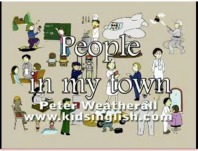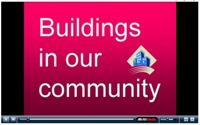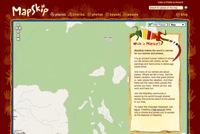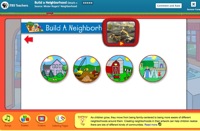Lesson 2: People and Places in Our Community
In this series of activities, we will continue to explore our community (Deerfield/Highland Park, Illinois). We will learn about people and places in the community and, as we read and discuss the information, will learn different ways to share information and stories. We will share stories about people and places in the community that are important to us and share them on our Communities Wiki.
Objectives:
Objectives:
- Represent ideas in a variety of ways
- Speak in front of a group
- Develop concept of self, family, school and community
- Develop and awareness of basic geographical concepts through the use of maps and globes
- Develop the ability to listen with discrimination
- Apply existing knowledge to generate new ideas, products, or processes
- create original works as a means of personal or group expression
- Interact, collaborate, and publish with peers
- Communicate information and ideas effectively to multiple audiences using a variety of media and formats
- Practice safe, legal, and responsible use of information and technology
- Exhibit a positive attitude toward technology that supports collaboration, learning, and productivity
- Understand and use technology systems
Motivational Activity: Build a Neighborhood
- Visit the Building a Neighborhood Website and use the online game to build a simple model of a neighborhood.
- Which type of neighborhood matches our community? Click on icon that is closest match.
- What do the different pictures mean? (discuss icons)
- What do we want in our neighborhood? Drag and drop images to canvas to “build” the neighborhood.
- Thinking about we know already about communities, what is missing from here?
- Think of one place in our community that we didn’t put in our online neighborhood. Draw a picture of it and write or tell why you think it is an important part of a community.
Preparatory Activity: Read-Aloud and Discussion

Tell your neighbor one thing you know about communities. Next tell a different neighbor what you know (same idea or a different one). Read a book in which a community is explored (below, or similar).How is this story the same as the other books we read about community? What is different about this book? What did you learn from this book that is different that the others we read?As time allows, read another book on this topic. Compare/contrast information and relate to own community.
Suggested Reading:
If You Give a Cat a Cupcake, by Laura Numeroff
Where Do I Live? by Neil Chesanow
Suggested Reading:
If You Give a Cat a Cupcake, by Laura Numeroff
Where Do I Live? by Neil Chesanow
Informational Activity: The People Song

Watch and sing along as we learn about the people in our town and what they do for their jobs. Watch with the sound off. Can you tell what jobs these people do? How can you tell? Watch again, this time with sound. Sing the song to learn about helpers in our community.
The song has subtitles in English and Korean. Many YouTube videos can be converted to mp3. Download the song as an mp3 file for a sing-along with the computer is not available or desired. Here is the link to convert People Song.
The song has subtitles in English and Korean. Many YouTube videos can be converted to mp3. Download the song as an mp3 file for a sing-along with the computer is not available or desired. Here is the link to convert People Song.
Informational Activity: Buildings in Our Community

Click on the image to watch the video in a new window.
Many communities have buildings like these, though they might look different. Do we have a Fire Station in our community? Have you ever seen it? What do you know about the fire station? What other buildings do we have in our community. Discuss purpose of various buildings. How do they help our community? What do you think it would be like to work there? Are they all fun places to go?
Many communities have buildings like these, though they might look different. Do we have a Fire Station in our community? Have you ever seen it? What do you know about the fire station? What other buildings do we have in our community. Discuss purpose of various buildings. How do they help our community? What do you think it would be like to work there? Are they all fun places to go?
Application Activity: Stories in Our Community

Read-Aloud: On the Town: A Community Adventure, by Judith Caseley
Armed with a black notebook, Charlie and his mother explore the community and the people who live in it, and decide what they should write about it.
Discussion: If you were going to write about some of the places in our community, which places would you write about? What do you think you would say about it? Share ideas with a neighbor. Write a Reader's Response about this story.
Armed with a black notebook, Charlie and his mother explore the community and the people who live in it, and decide what they should write about it.
Discussion: If you were going to write about some of the places in our community, which places would you write about? What do you think you would say about it? Share ideas with a neighbor. Write a Reader's Response about this story.
Application Activity: Stories of Our Community / Mapping

Use MapSkip to create stories of our community. For a video tour of MapSkip click here.
Click on the hand marker at the Deerfield Train Station to see an example of a story and photo. Next, click on the hand marker at Kipling School. As teacher types, children suggest ideas. Find two or three other areas of interest and add markers and stories. Put video tour on blog/wiki and invite families to add markers and stories to the map. Check back in a few days to see what's new!
Click on the hand marker at the Deerfield Train Station to see an example of a story and photo. Next, click on the hand marker at Kipling School. As teacher types, children suggest ideas. Find two or three other areas of interest and add markers and stories. Put video tour on blog/wiki and invite families to add markers and stories to the map. Check back in a few days to see what's new!
Application Activity: The People in My Community
- Watch video: Community Helpers
- Activity: Make a drawing that shows a person or in the community and write/tell about it.
- Brainstorm: Generate a list of people in the community that are important to children. Some possibilities: Ray and Celeste (our crossing guards), lifeguards at the pool, police officers, firefighters, people that work in schools (teacher, secretary, nurse, principle, etc), coaches, workers (electricity, water, phone).
- Pair-Share ideas then work time.
- Scan student artwork (it will end up in an eBook).
- Teacher or adult helper conference with kids to create the text for their page in the class book.
- When it's finished, post in online to share with families and friends.
This activity could also be done as a Places in My Community Book.
Application Activity: Community Helpers Themed Activities

Community Helpers Theme: Visit a Web site with lots of art activities for a Communities Thematic Unit. Teachers select from a wide variety of art activities that will allow students to share what they know about community helpers.
Flipbook of Hats: Make a flipbook! Color the hats of the community helpers then flip the pages to see the hats change. View the PDF below, originally the EdHelper Web site (http://edhelper.com/art_theme.htm), for project ideas.
Flipbook of Hats: Make a flipbook! Color the hats of the community helpers then flip the pages to see the hats change. View the PDF below, originally the EdHelper Web site (http://edhelper.com/art_theme.htm), for project ideas.
Closure/Review Activity: Who Are the People in Your Neighborhood

This Sesame Street footage uses the well-known song, Who Are the People in Your Neighborhood, and puts an historical spin on it. In it we are introduced to people that would be in your neighborhood during the time of George Washington - Candlemaker and the Saddler. Additional “classic” Sesame Street versions of the song are also available.
Grocer and Doctor version
Grocer and Doctor version
Assessment Suggestions for Teachers:
Promethean Planet Resource: Community Helpers
Identify who community helpers are, the tools they use, and the goods and services they provide. This flipchart uses Activotes. If students have not used Activotes before, peer buddies could help.
URL: http://www.prometheanplanet.com/en-us/Resources/Item/55821/community-helpers/
Community Helper Illustration and Text - Rubric
Students may dictate or handwrite text. Look for:
Use the D109 Kindergarten Reader Response Rubric for scoring (available to staff on district web site).
Identify who community helpers are, the tools they use, and the goods and services they provide. This flipchart uses Activotes. If students have not used Activotes before, peer buddies could help.
URL: http://www.prometheanplanet.com/en-us/Resources/Item/55821/community-helpers/
Community Helper Illustration and Text - Rubric
Students may dictate or handwrite text. Look for:
- Both the text and drawing relate to a helper (or place) in the community.
- Illustration includes a human figure (or appropriate location) and one or more images, objects or symbols that are representative.
- Length requirement is met: Writing by hand – one sentence, Dictation -– three or more sentences.
Use the D109 Kindergarten Reader Response Rubric for scoring (available to staff on district web site).

